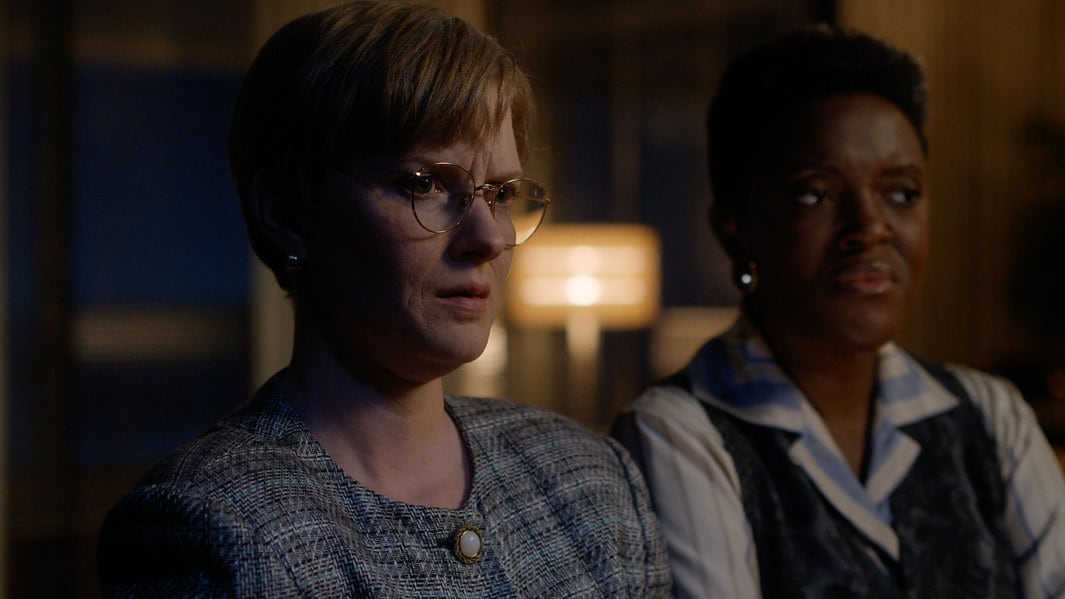Spoilers ahead for the first two seasons of For All Mankind.
America does not like to lose, and neither does AppleTV+.
But right out of the gate, For All Mankind seemed doomed to be the streaming platform’s biggest failure to launch. Billed as “Mad Men at NASA,” a drama about space jocks and their nervy little buddies at mission control dealing with the fallout of the Soviets getting to the moon first, the first season of the show was released in 2019 to tepid shrugs.
It was stylish, sober, and schmaltzy, sure, but its history didn’t seem to be all that “alt” (barring the dames suiting up for astronaut training in 1969). It didn’t stand out in what was, even back in the halcyon days of 2019, a choked streaming landscape. Thanks for making the effort, Houston; better luck next time.
Then something miraculous happened. For All Mankind came back for its sophomore season in 2021, and someone must have flicked the artificial gravity switch off, because the moon show hit that sucker clear out of the stratosphere. All of a sudden, critics were pulling about-faces, swapping sibilant adjectives like “saccharine” and “slow” for “stellar” and “spectacular.”

A common refrain emerged, one that picked back up in earnest last week, when the third season of For All Mankind premiered: that it has become, without much warning, the Best Show You Haven’t Watched.
Like the Internet’s Boyfriend award, this tends to be a fleeting title, and not one bestowed without some well-deserved suspicion from outsiders. But—at least for this particular nanosecond in the current zeitgeist—it’s completely deserved. The show about the never-ending space race has simply gotten better with time.
So what happened between Seasons 1 and 2? Simply put: about a decade. For All Mankind’s first season took place between 1969 and 1974; its second in 1983, with nuclear war on the moon suddenly a realistic possibility, and all the same characters in wildly different places in their lives. For All Mankind abandoned its characters’ younger selves and took a flying leap, having barely given viewers time to get attached. And then—madness!—it happened again, with Season 3 jumping to 1992. Now, NASA and Roscosmos are preparing to send their intrepid employees to the moon.
This lightspeed narrative pace has allowed For All Mankind to go from retro to futuristic in the space of two decades of in-universe time. Despite—or perhaps because of—this breakneck acceleration, it has also somehow managed to titrate a near-perfect balance of vibes and substance in the little under three years it’s been available to stream.
The show is oozing with prestige; lofty with its highfalutin ideals and optimism; and competence porn at its finest. It also loves its schlock. It relies heavily on bombastic spectacle and is chock-full of moments that make you want to hiss at the aeronautical engineer or astronaut you’re watching: “You moron!”
This balance was showrunner Robert D. Moore’s devious plan all along, of course, alongside his wily writing staff and scheming co-creators Matt Wolpert and Ben Nedivi. Both its alternate timeline and, I suspect, its quality were deliberately structured along a guardrail shaped like an exponential curve. It was built to evolve, and that’s thanks to the 10-year time jumps between its seasons.
Time jumps aren’t a rare device in television, but for years they were a pretty reliable omen of a show that desperately needed a shot of adrenaline to the heart.
The Walking Dead, True Blood, Pretty Little Liars, Six Feet Under, and The Mentalist all skipped years into the future after achieving record-low ratings or running out of creative steam. Riverdale featured a fifth-season time jump of seven years because the writers had presumably run out of other ways to torture the cast.
Sometimes time jumps were a practical necessity, such as in the case of a main star’s exit (The Resident; The Blacklist) or because those cute child actors you hired are growing up faster than Netflix can print money (as in the case of Stranger Things’ forthcoming fifth season).
Time jumps were not a universal portent of doom, or even the sign of a show lazily juicing itself the narrative equivalent of steroids. But even in the cases where hopping into the future worked for audiences and critics, shows like Battlestar Galactica, Parks and Rec, The Americans, and Halt and Catch Fire only ever pulled that particular rabbit out of their hat once, and then only to skip a handful of years—one, two, three, and four, respectively.

To put it mildly: time jumps are a gamble, and the risk of crashing and burning is magnified every time you do it. But For All Mankind is risk all the way down. Moore, Wolpert, and Nedivi chanced loss of viewership by taking the time to lay the groundwork for what would eventually become their grand alt-history timeline early in the first season. Lingering on setup can be a fatal error in the world of streaming, which is full of executives fairly itching to scrap a show that appears as though it’s still groping around for its voice.
Making your show an alt-history compounds the gambit. The whole point of the subgenre is to deviate from existing roadmaps, which makes for wildly varying results, from the good (Man in the High Castle) to the bad (Hollywood) to the thank-god-it-never-got-off-the-ground (Confederate).
For All Mankind, though, proved itself in its second season to be the kind of show with the stones not only to kill off two of its best characters but to do so while both were sprinting across the surface of the moon wrapped in nothing but duct tape and attempting to avert a nuclear meltdown. (It sounds unbelievable from the description alone, but the sequence rivals any in Severance’s finale.) To hear Moore describe it, the soul of the show is in the wager.
“I think one of the things the show has said from literally the first episode is that we as a culture, and we as NASA as a representative of the public, have become too risk-averse,” he told The Daily Beast last week. “... Part of the show has said, from the get-go, there’s going to be tragedies. Things are going to happen. It’s going to be bad. But we shouldn’t overcorrect to the point where we just can’t fly anymore.”
Unlike any other show that has come before it, though, time jumps are absolutely critical to For All Mankind. This is because, unlike other alt-histories, it starts at the point of divergence from our own reality. Whereas shows like The Man in the High Castle, Watchmen, and, hell, even Bridgerton begin in media res, throwing the viewer into a new world already fully formed, For All Mankind’s pilot opens in our world—only for millions of Americans to learn moments later that the commies made it to the moon first.
Critics only began to notice in its second season that the more For All Mankind detached itself from our reality, leaning into its butterfly effect, the stronger it became. The Soviets’ landing gave way to both sides planting military bases and nuclear reactors on the moon in the ’80s, leading indirectly to, among other things, the death of Margaret Thatcher at the hands of the IRA; the Beatles’ reunion tour after John Lennon’s narrow escape of an assassination attempt; and the 1984 election of Gary Hart as U.S. president.
All of this is handily delivered to the audience via a heavily deepfaked montage at the top of the third season, and all of it is contextual garnish to the narrative proper, which remains focused on the tension between humanity and the vast eternity of space.
Because of its time jumps, For All Mankind is able to think in fictional lifetimes rather than seasons. When it leaps ahead chronologically, the show has to believably drag its characters (and their baggage, and their resistance to change) along with it.
Aleida isn’t just a talented but troubled young engineer that Margo struggles as a supervisor to handle; years ago, she was the little girl that Margo refused to adopt after she had her entire family ripped away from her. Gordo still carries a torch for Tracy after their divorce in the gap between Seasons 1 and 2, but his sad-sack routine isn’t grating because we remember the look on his face when she walked into mission control, safe, after risking her life in space.

Even now, in the third season, Dani and Ed’s every exchange as they compete for command of a planned mission to Mars is punctuated by the fact that, 20 years ago, they spent several months marooned on the moon together. None of this subtext needs to be explained after the fact because, in a sense, we’ve grown up with these characters—even without watching it slowly unfold in real time.
It’s thanks to that accumulated narrative efficiency that the third season kicks off with a firecracker that, on another show, would have been a season finale. Like the space hotel Polaris in that episode, we’re really spinning now, baby.
Moore has said that time jumps will continue to be a fixture of the show, for which his writing staff has sketched out a rough seven-season plan. Beyond that, where exactly For All Mankind is headed is anyone’s guess. But the direction is clear: forward.






